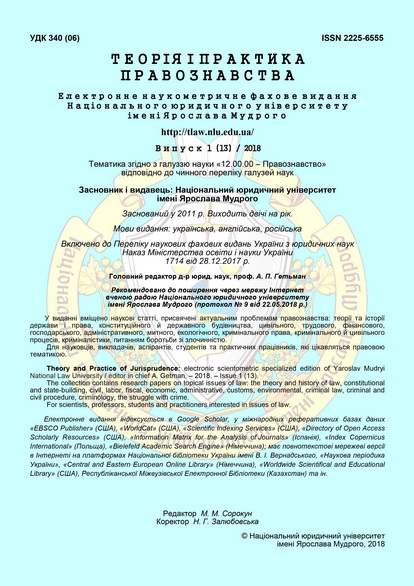The principle of division of state power and the system of checks and balances: genesis and implementation in Ukraine
DOI:
https://doi.org/10.21564/2225-6555.2018.13.132069Keywords:
the principle of division of state power, system of checks and balances, higher state authorities, branch of power, organization of state power, unity of state power, distribution of powers, interaction of the highest bodies of state powerAbstract
The article analyzes the historical experience of implementing the principle of separation of powers in different countries of the world for further theoretical development of the most optimal model of organization of state power of Ukraine on the basis of its division into legislative, executive and judicial branches and ensuring the effective functioning of the system of checks and balances. It has been established that this democratic principle is enshrined in Article 6 of the Constitution of Ukraine.
Analyzing historical experience and trying to find the roots of the theory of separation of powers from the ancient authors, we conclude that scientists forget that for the Antiquity, the Middle Ages, and for the Renaissance, this idea was practically absent. Then it was discussed more about the division of separate functions of state power. For the first time, the question of the emergence of the theory of separation of powers in the modern sense is drawn to J. Locke in 1688. The purpose of the state, he sees in preserving the freedom and property acquired as a result of labor. Another thinker who grounded this idea was Sh. -L. Montesquieu. In his opinion, in a properly organized state, there is no single power, and there must be three independent power from each other: legislative, executive and judicial. Any association in the hands of one body inevitably leads to abuse.
It was established that the theory of separation of powers was perceived by the constitutions of many countries, although the concrete forms of its implementation were very diverse. During the times of Soviet power in our country, the principle of separation of powers was rejected as alien and unacceptable and, at best, was considered as a normal division of labor, and only after the declaration of independence, this principle was clearly defined.
On the basis of the foregoing, it was concluded that contemporary views on the mechanism of the principle of the division of a unified state power are reduced to the fact that in the process of organization and implementation of state power various different functions and powers are used in their designation and function in relation to independent state bodies that are mutually controlling in the course of their activities each other through a system of checks and balances es New Roman","serif"; mso-fareast-font-family:"Times New Roman";mso-ansi-language:EN-US;mso-fareast-language: UK;mso-bidi-language:AR-SA'>abuse its constitutionally determined powers and, as a result, will infringe the Fundamental Law of Ukraine, in particular, its second section of article 19, according to which bodies of public power and their officials are obliged to act only on the grounds, within the limits of authority, and in the manner envisaged by the Constitution and the laws of Ukraine. However, the legislator is still able to prevent appearance of the above situation by necessary amendments to the Law of Ukraine «On the Constitutional Court of Ukraine»References
Aver’ianov, V.B. (1997). Orhany vykonavchoi vlady v Ukraini. Kyiv: In Yure [in Ukrainian].
Avtonomov, A.S. (1999). Pravovaja ontologija politiki: k postoeniju sistemy kategorij. Moscow: Infograf [in Russian].
Bespalyj, I.T., Poljanskij, V.V. (2008). Gosudarstvennoe pravo Rosijskoj Federacii. Samara: Samarskij universitet [in Russian].
Kistjakovskij, B.A. (1999). Filisofija i sociologija prava: monografija. St. Petersburg: RHGI [in Russian].
Konstytutsiia Ukrainy: stanom na 25 serp. 2017 r.: vidp. ofits. tekstu (2017). Kharkiv: PPF «Polihrafist» [in Ukrainian].
Konstytutsiia Ukrainy: nauk.-prakt. koment. V.Ya. Tatsii (Ed.) et al. (2003). Kharkiv: Pravo [in Ukrainian].
Osaveljuk, A.M. (1998). Vspomogatel’nye gosudarstvennye organy zarubezhnyh stran: konstitucionno-pravovoj aspekt. Moskva: Jurist [in Russian].
Tysiacha rokiv ukrainskoi suspilno-politychnoi dumky. (Vols. 1–9); Vol. 4, part 1: Persha tretyna XVIII st. (2001). T. Hunchak, O. Slipushko (Eds). Kyiv: Dnipro [in Ukrainian].
Tolstenko, V. (2014). Pryntsyp podilu vlady v henezi formy suchasnoi derzhavy. Yurydychna Ukraina – Legal Ukraine, 5, 15–21 [in Ukrainian].
Frytskyi, Yu.O. (2006). Zakriplennia orhanizatsii ta funktsionuvannia derzhavnoi vlady v Konstytutsii Ukrainy 1996 roku. Visnyk Zaporizkoho yurydychnoho universytetu – Visnyk of Zaporizhzhya National University, 2 (35), 3–11 [in Ukrainian].
Shapoval, V.M. (1994). Ideia rozpodilu vlad u konstytutsiinii teorii i praktytsi v Ukraini. Visnyk akademii pravovykh nauk Ukrainy – Herald of the Academy of Legal Sciences of Ukraine, 2, 29–37 [in Ukrainian]
Downloads
Published
How to Cite
Issue
Section
License
Copyright (c) 2018 Theory and practice of jurisprudence

This work is licensed under a Creative Commons Attribution 4.0 International License.




